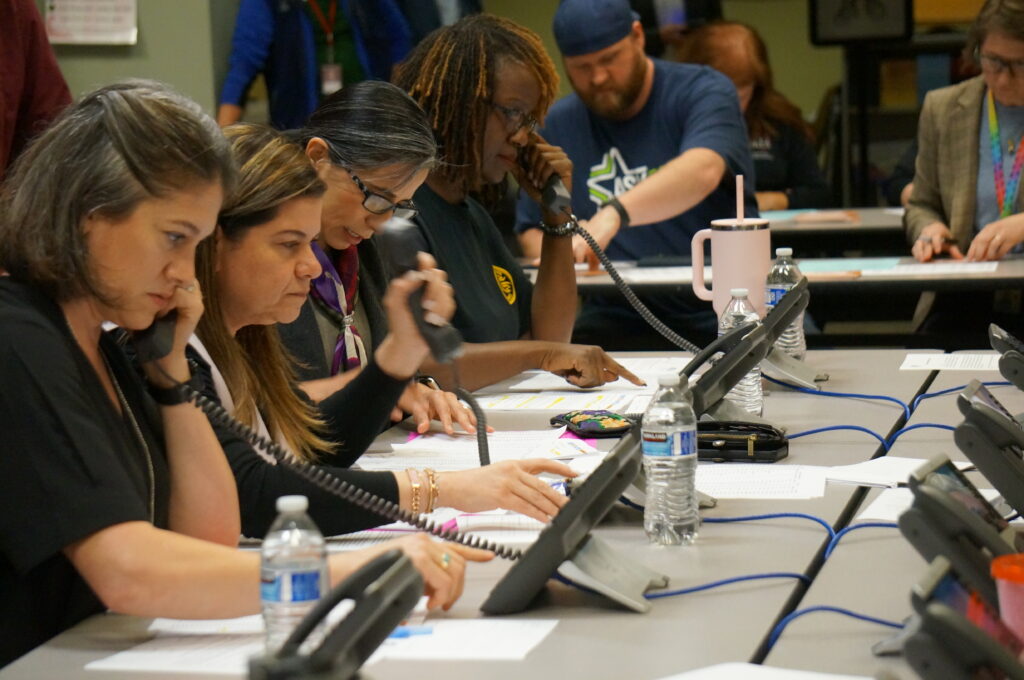Salem-Keizer School District Superintendent Andrea Castañeda (left) and Oregon Department of Education Director Charlene Williams (third from left) joined district employees at a phone banking event at Waldo Middle School in Salem Oct. 15 to praise the parents of students who were improving their overall school attendance. (Alex Baumhardt/Oregon Capital Chronicle)
Several parents in the Salem-Keizer School District this week picked up their phones to a surprise call from Oregon Gov. Tina Kotek.
She was calling from Waldo Middle School in northeast Salem, along with Oregon Department of Education Director Charlene Williams and about 20 other district administrators, thanking them for getting their kids to school. Like many districts in the state, Salem Keizer is struggling with chronic absenteeism that’s gotten worse since the pandemic. Parents who received calls from Kotek and others Tuesday have children who are attending school at a significantly higher rate than they were during the first six weeks of the previous school year.
The calls were part of Every Day Matters, an initiative from the state education department that’s being spearheaded in several Oregon districts such as Salem-Keizer. It’s a response to worrying declines in regular student attendance since the pandemic that Kotek said needed to be responded to with “urgency.”
Students who miss 16 or more school days in a 160-day school year are considered to be chronically absent. Statewide, nearly 40% of Oregon students were chronically absent during the 2022-23 school year, the most recent year of data. That’s a 20 percentage point increase in absenteeism from the 2018-19 school year. In the Salem-Keizer School District, Oregon’s second largest after Portland, nearly half of students were chronically absent during the 2022-23 school year.
Absenteeism rates in Oregon are highest in kindergarten, early elementary grades and among high school seniors, according to state data and school districts. Education experts say absences in the younger grades can have the most impact, and research shows students who are chronically absent in preschool, kindergarten and first grade are much less likely to read at grade level by third grade, making them four times more likely to drop out of high school than proficient readers. In Salem-Keizer, English language arts proficiency across all grades is down nearly 16 percentage points from pre-pandemic levels, according to the latest state assessment data. About 31% of students across all grades in the district are considered proficient in English.
Williams called student attendance a “lead domino.”
“When they show up, now, we can do all the other things: Improving literacy, all the things that we’re doing to try to improve student outcomes,” she said.
Reaching families
The idea behind the Every Day Matters campaign is to equip districts with strategies to boost attendance, including talking directly with families and collecting and using attendance data more effectively. Each of the state’s 19 Education Service Districts is staffed with an Every Day Matters liaison to help districts with planning and reaching parents and students over the phone and at home, according to Williams.
District leaders in Salem said the reason for student absences often depends on the grade. There’s still a sense among some families that kindergarten is pre-school and optional, according to Aaron Harada, a spokesperson for the district who attended the phone banking event.
For the students at Waldo Middle School, getting up and onto the bus without the assistance of a parent can be the deciding factor. Principal Ingrid Ceballos said many parents of students at the school are migrant workers who can’t be home to supervise their kid getting ready for school every day. Oftentimes, if a student wakes up late and misses the bus, there is no other way for them to get to school except walking a long distance, she said.
Ceballos works with families on plans to make sure alarms and buses aren’t missed, and she said they’ve had some success with offering students incentives for hitting attendance milestones, such as gift cards to coffee shops or taking students out to lunch. Other times, it’s less carrot than stick.
“Sometimes it’s a tough conversation with me and just saying: ‘Hey, I need you here. This is how that’s going to happen. We need to make sure that you’re in school,’” she said.
District-wide, automated phone systems that call parents when their child has an unexcused absence will now also call at the end of the month to let parents know how many days, cumulatively, their child has missed, according to Harada.
“As a parent, you get notified every day your child is absent, but you might not be thinking of it in terms of ‘Wow, in the past 30 days, they missed 13 days,” Harada said.
Some district administrators have bemoaned the Legislature’s decision in 2021 to end laws allowing districts to fine parents, or to have judges and truancy courts mandate students attend school, if they’d missed a significant number of days.
Need for ‘one-on-one’ contact
During the 2023 legislative session, an 18-member taskforce was created to submit ideas for boosting student attendance that would not require legal enforcement.
“What we do know works is that personal, one-on-one with the families and making sure you’re reducing barriers,” she said.
Kotek said home visits can be particularly effective though most large districts might lack staff. Salem-Keizer, for example,laid off more than 100 staff due to budget cuts this school year. Statistically, hundreds of students a day in the district are not showing up.
Kotek noted that student absenteeism is also a symptom of statewide problems, like unstable housing. Students who frequently move are highly likely to miss large numbers of school days.
“Housing is an answer here,” Kotek said. “That takes a little longer, right? Rent assistance for families takes longer. So it’s not one thing, right?”
GET THE MORNING HEADLINES.

